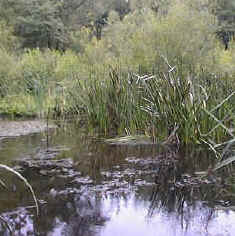Walking through a
Wetland ...
Dry Land |
>> | Marsh |
>> | Swamp |
Open Water |
|
Swamp to Open Water Continuing into the wetland, the tall sword-shaped leaves of the swamp plants gradually give way to open water. The open water has different plants still, to the marsh and swamp areas of the wetland. Tiny leaflets of Duckweed float on the surface, while Pondweed grows submerged in the water below. Clinging to its underwater fronds are a variety of aquatic herbivores such as Mayfly and Caddisfly larvae. Small fish such as Sticklebacks lurk in the water, waiting to catch minibeasts such as small worms and larvae. As you continue the Discovery Trail, you will find out about some of these animals. |
| . The great variety of different microhabitats ('mini' habitats) within the wetland means that are also an enormous number of different kinds of plants and animals living there. There are over 100 different kinds of plants in the wetlands at Offwell and each kind has a different range of animals living on and around them. Sadly, wetland areas have declined to a great extent in Britain. They will in any case, naturally dry up over time, as the plant roots and old stems trap more and more mud. However, many wetland areas have also been drained and removed to make way for human development. With the loss of these precious habitats, many once common species such as the Common Frog, are now no longer common and many species of dragonflies have become extinct in Britain. |
|
Now continue to the Discovery Trail!
